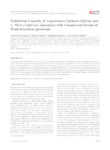Please use this identifier to cite or link to this item:
http://www.alice.cnptia.embrapa.br/alice/handle/doc/916093| Title: | Nodulation capacity of Argentinean soybean (Glycine max L. Merr) cultivars inoculated with commercial strains of Bradyrhizobium japonicum. |
| Authors: | SALVUCCI, R. D.  AULICINO, M.   HUNGRIA, M.   BALATTI, P. A.   |
| Affiliation: | RUBÉN DARÍO SLAVUCCI, Universidad Nacional de La Plata - La Plata, Argentina; MONICA AULICINO, Universidad Nacional de La Plata - La Plata, Argentina; MARIANGELA HUNGRIA DA CUNHA, CNPSO; PEDRO ALBERTO BALATTI, Universidade de La Plata - La Plata, Argentina. |
| Date Issued: | 2012 |
| Citation: | American Journal of Plant Sciences, Irvine, v. 3, n. 1, p. 130-140, Jan. 2012. |
| Description: | The purpose of this research was to evaluate the nodulation potential of 31 Argentinean soybean commercial cultivars. Those with the highest nodulation capacity developed twice the amount of nodules than the low nodulating ones, which is the variation contained in soybean genotypes. Furthermore, this was not due to bacterial promiscuity, since the re-sponse was independent of the bradyrhizobia strain inoculated. The ability of cultivars to develop a larger number and biomass of nodules was unrelated with the maturity group they belong to and also was not a response to quorum sensing effects. Our results suggest that breeding programs can be aimed at improving the nodulation capacity of soybean and that cultivars from different maturity groups can be a source of nodulation QTLs. |
| Thesagro: | Fixação de Nitrogênio |
| DOI: | 10.4236/ajps.2012.31015 |
| Type of Material: | Artigo de periódico |
| Access: | openAccess |
| Appears in Collections: | Artigo em periódico indexado (CNPSO)  |
Files in This Item:
| File | Description | Size | Format | |
|---|---|---|---|---|
| hungria.nodulation.pdf | 349,84 kB | Adobe PDF |  View/Open |









